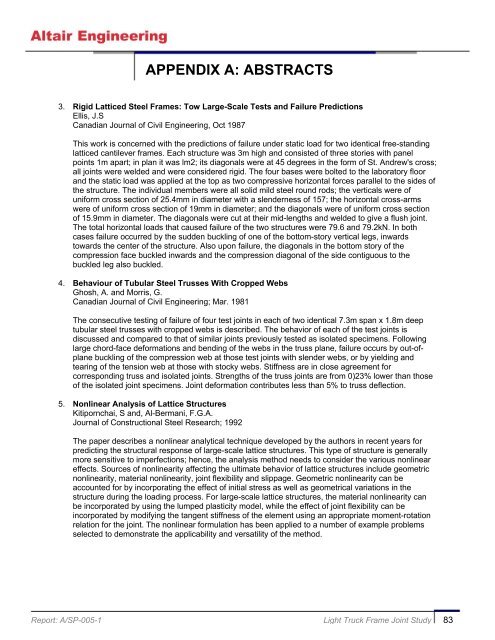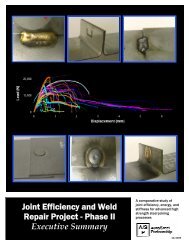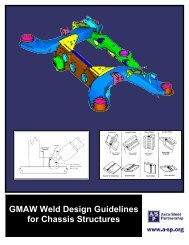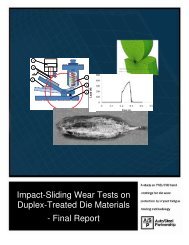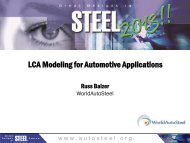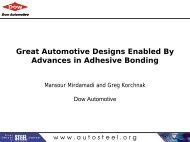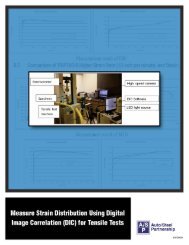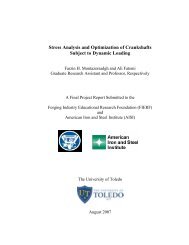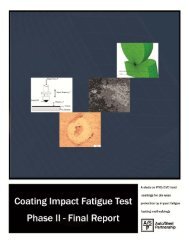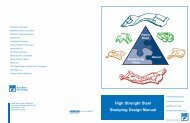Light Truck Frame Joint Stiffness Study Phase 1 Final Report
Light Truck Frame Joint Stiffness Study Phase 1 Final Report
Light Truck Frame Joint Stiffness Study Phase 1 Final Report
You also want an ePaper? Increase the reach of your titles
YUMPU automatically turns print PDFs into web optimized ePapers that Google loves.
APPENDIX A: ABSTRACTS<br />
3. Rigid Latticed Steel <strong>Frame</strong>s: Tow Large-Scale Tests and Failure Predictions<br />
Ellis, J.S<br />
Canadian Journal of Civil Engineering, Oct 1987<br />
This work is concerned with the predictions of failure under static load for two identical free-standing<br />
latticed cantilever frames. Each structure was 3m high and consisted of three stories with panel<br />
points 1m apart; in plan it was lm2; its diagonals were at 45 degrees in the form of St. Andrew's cross;<br />
all joints were welded and were considered rigid. The four bases were bolted to the laboratory floor<br />
and the static load was applied at the top as two compressive horizontal forces parallel to the sides of<br />
the structure. The individual members were all solid mild steel round rods; the verticals were of<br />
uniform cross section of 25.4mm in diameter with a slenderness of 157; the horizontal cross-arms<br />
were of uniform cross section of 19mm in diameter; and the diagonals were of uniform cross section<br />
of 15.9mm in diameter. The diagonals were cut at their mid-lengths and welded to give a flush joint.<br />
The total horizontal loads that caused failure of the two structures were 79.6 and 79.2kN. In both<br />
cases failure occurred by the sudden buckling of one of the bottom-story vertical legs, inwards<br />
towards the center of the structure. Also upon failure, the diagonals in the bottom story of the<br />
compression face buckled inwards and the compression diagonal of the side contiguous to the<br />
buckled leg also buckled.<br />
4. Behaviour of Tubular Steel Trusses With Cropped Webs<br />
Ghosh, A. and Morris, G.<br />
Canadian Journal of Civil Engineering; Mar. 1981<br />
The consecutive testing of failure of four test joints in each of two identical 7.3m span x 1.8m deep<br />
tubular steel trusses with cropped webs is described. The behavior of each of the test joints is<br />
discussed and compared to that of similar joints previously tested as isolated specimens. Following<br />
large chord-face deformations and bending of the webs in the truss plane, failure occurs by out-ofplane<br />
buckling of the compression web at those test joints with slender webs, or by yielding and<br />
tearing of the tension web at those with stocky webs. <strong>Stiffness</strong> are in close agreement for<br />
corresponding truss and isolated joints. Strengths of the truss joints are from 0)23% lower than those<br />
of the isolated joint specimens. <strong>Joint</strong> deformation contributes less than 5% to truss deflection.<br />
5. Nonlinear Analysis of Lattice Structures<br />
Kitipornchai, S and, Al-Bermani, F.G.A.<br />
Journal of Constructional Steel Research; 1992<br />
The paper describes a nonlinear analytical technique developed by the authors in recent years for<br />
predicting the structural response of large-scale lattice structures. This type of structure is generally<br />
more sensitive to imperfections; hence, the analysis method needs to consider the various nonlinear<br />
effects. Sources of nonlinearity affecting the ultimate behavior of lattice structures include geometric<br />
nonlinearity, material nonlinearity, joint flexibility and slippage. Geometric nonlinearity can be<br />
accounted for by incorporating the effect of initial stress as well as geometrical variations in the<br />
structure during the loading process. For large-scale lattice structures, the material nonlinearity can<br />
be incorporated by using the lumped plasticity model, while the effect of joint flexibility can be<br />
incorporated by modifying the tangent stiffness of the element using an appropriate moment-rotation<br />
relation for the joint. The nonlinear formulation has been applied to a number of example problems<br />
selected to demonstrate the applicability and versatility of the method.<br />
<strong>Report</strong>: A/SP-005-1 <strong>Light</strong> <strong>Truck</strong> <strong>Frame</strong> <strong>Joint</strong> <strong>Study</strong> 83


